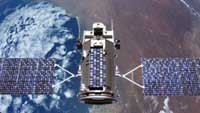Sep 28 2008
Members of the public can send their names around Earth on NASA's Glory satellite, the first mission dedicated to understanding the effects of particles in the atmosphere and the sun's variability on our climate.
 Glory low Earth orbit (LEO) scientific research satellite
Glory low Earth orbit (LEO) scientific research satellite
The "Send Your Name Around the Earth" Web site enables everyone to take part in the science mission and place their names in orbit for years to come.
Participants will receive a printable certificate from NASA and have their name recorded on a microchip that will become part of the spacecraft. The deadline for submitting names is Nov. 1, 2008.
The Glory satellite will allow scientists to measure airborne particles more accurately from space than ever before. The particles, known as "aerosols," are tiny bits of material found in Earth's atmosphere, like dust and smog.
"Undoubtedly, greenhouse gases cause the biggest climatic effect," said Michael Mishchenko, the Glory project scientist at NASA's Goddard Institute for Space Studies in New York. "But the uncertainty in the aerosol effect is the biggest uncertainty in climate at the present."
Glory will carry two scientific instruments, the Aerosol Polarimetry Sensor, or APS, and the Total Irradiance Monitor, or TIM, and two cameras for cloud identification. The APS instrument will help quantify the role of aerosols as natural and human-produced agents of climate change more accurately than existing measurement tools. The TIM instrument will continue 30 years of measuring total solar irradiance, the amount of energy radiating from the sun to Earth, with improved accuracy and stability. Understanding the sun's energy is an important key to understanding climate change on Earth.
Glory is scheduled for launch in June 2009 from Vandenberg Air Force Base in California. Glory will orbit as part of the Afternoon Constellation, or "A-Train," a series of Earth-observing satellites. The A-Train spacecraft follow each other in close formation, crossing the equator a few minutes apart shortly after 1:30 p.m. local time each day. The A-Train orbits Earth once every 100 minutes.
NASA's Goddard Space Flight Center in Greenbelt, Md., is responsible for Glory project management. Orbital Sciences Corporation in Dulles, Va., is responsible for development, integration and operations of the spacecraft. Raytheon in El Segundo, Calif., is responsible for development of the APS. The Laboratory for Atmospheric and Space Physics in Boulder, Colo., is responsible for the development of the TIM. Glory's cloud cameras were built by Ball Aerospace and Technologies of Boulder.